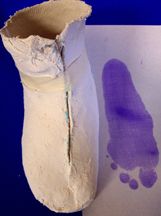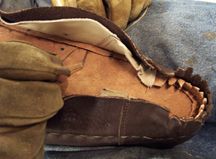Diabetes & Footwear
Diabetes and Footwear
Although proper shoe fit is important for everyone, for people with diabetes it is literally a matter of life and limb. There are two primary types of diabetes. Type 1 is often referred to as juvenile diabetes and Type 2 is the form that commonly occurs in adults 45 years of age or older. Because of the nerve damage and poor circulation that often accompany the disease, diabetes is the most common cause of non-traumatic lower limb amputations.
Properly Fitted Shoes Are Essential
Proper care, cleaning and examination of the feet is critical for people with diabetes. According to the Canadian Diabetes Association ( www.diabetes.ca ) all people living with diabetes should have their feet examined at least once a year to avoid the risk of developing foot problems.
Poorly fit shoes are involved in as many as half of the problems that lead to amputations in the United States . In Canada , it is estimated that 80-200,000 individuals living with diabetes will be affected by foot problems, such as ulcers in their lifetime. Of those, 14-24% will be at risk of losing a lower limb or foot through amputation.
It is absolutely imperative that people with diabetes follow the advice of their doctor concerning all aspects of their diabetes—including the doctor’s instructions to wear proper shoes that are properly fit. For diabetes sufferers with peripheral neuropathy, this requires the care of a Certified Pedorthist ( Canada ).
A person with peripheral neuropathy lacks the very sensation required to feel the fit of the shoe . Therefore, it is imperative for a person with peripheral neuropathy to seek the assistance of a trained expert to assure a proper shoe fit.
A Certified Pedorthist, trained in shoe fitting and diabetic foot management, can expertly select and fit the proper shoe for a person with diabetes. Some people with diabetes have purchased footwear that was too small, causing an ulcer, because they had not been fitted by a trained expert.
People with peripheral neuropathy nearly always insist on a size that is too small because without proper sensation, the correct size seems to be too large. Too small of a shoe can cause a blister or abrasion that can result in an ulcer, which can eventually lead to an amputation. DON’T RISK LOSING YOUR FEET DUE TO POORLY SELECTED OR INCORRECTLY FITTED SHOES! Sometimes you don’t get a second chance!
Monofilament Testing
A heavy piece of nylon thread is used to touch 5 specific places on the bottom of each foot. Should a loss of sensation be found, contact your physician immediately.
Caring For Your Feet
- Always follow your doctor’s instructions for foot care.
- Revisit your Canadian Certified Pedorthist one week after getting new footwear and no less than once every three months for a check-up.
- Keep your blood sugar in control.
- Inspect your feet for trouble signs everyday; report any changes to your physician. If it is difficult for you to see your feet, try using a mirror.
- Wash your feet daily using lukewarm water and mild soap. Test the water temperature first with your elbow.
- Dry your feet carefully with a soft towel, especially between the toes.
- Dust your feet with talcum powder or cornstarch.
- Use approved creams, lanolin lotion or petroleum jelly if the skin is dry. Be careful not to get it between the toes.
- Check your shoes, socks, and orthoses daily for stones or foreign objects that can cause sores.
- Wear thick, soft socks—preferably socks designed for the diabetic foot. Avoid mended socks or those with seams. Change socks daily. Avoid knee-highs or dress socks with tight elastic bands.
- Do not wear shoes without socks.
- Never go barefoot – wear some sort of supportive footwear at all times to avoid cuts or other foot injuries, particularly if you have loss of sensation.
- If your feet are cold at night, wear loose, seam-free socks to bed. Do not use hot water bottles or heating pads.
- Shop for shoes in the afternoon, when your feet are the largest.
- Don’t smoke.
- Leave foot surgery to the experts; see your doctor, foot care nurse or a chiropodist if you develop corns, calluses, or ingrown nails. Do not use sharp instruments or home remedies unless approved by your doctor.
- Let your doctor, foot care nurse or a chiropodis cut your toenails. If you must cut them yourself, cut toenails straight across. Never cut into the corners or taper. Use an emery board or nail file for sharp edges.
The Facts
Approximately 2 million Canadians have been diagnosed with diabetes (about one out of every eighteen), and that number is growing. About 65% of people with diabetes have a mild to severe form of nerve damage (called peripheral neuropathy) that can deprive them of their protective sensation in their feet.
This lack of sensation makes it impossible to determine if their shoes fit or to detect foot abrasions from socks, misfit shoes or foreign objects in the shoe or on walking surfaces. These abrasions often don’t heal because of the poor circulation that accompanies diabetes. These non-healing abrasions become ulcers, which can get infected or gangrenous. If the infections go unchecked, the limb will have to be amputated.
Statistics show that 30% of diabetics that lose one limb from amputation will lose the other limb within three years. Sixty percent of people with diabetes will die within five years of their first lower limb amputation.
These statistics show why it is so imperative to prevent the “first” lower limb amputation.
Shoes, Custom Shoes and Orthoses
People with diabetes usually require foot orthoses to balance and protect the foot and to unload and alleviate diabetic foot problems. The diabetic foot is the hardest foot to manage because it has all of the biomechanical challenges that non-diabetic feet have, coupled with the soft tissue challenges related to diabetes. Canadian Certified Pedorthists are specifically trained to manage diabetic feet and to help in the healing of current ulcers and the prevention of future ulcers.


Most people’s diabetic feet can be managed with off-the-shelf shoes. However, in many cases, including many Charcot conditions, a custom molded shoe is the best treatment for the person with diabetes. Your Pedorthist will explain the construction and performance expectations of your shoes, inserts, or foot orthoses.
Remember that all inserts and orthoses work as a unit with the shoes you are wearing. If your shoes are improper or fit incorrectly, the orthoses can even cause harm rather than alleviate it.
|
Make sure you check your feet, shoes, and insoles/orthoses regularly. Revisit your Canadian Certified Pedorthist for a check-up within one week of purchasing any new footwear from Stride. Remember to revisit your Canadian Certified Pedorthist for a check-up at least every three months.
You owe it to your feet!
|

